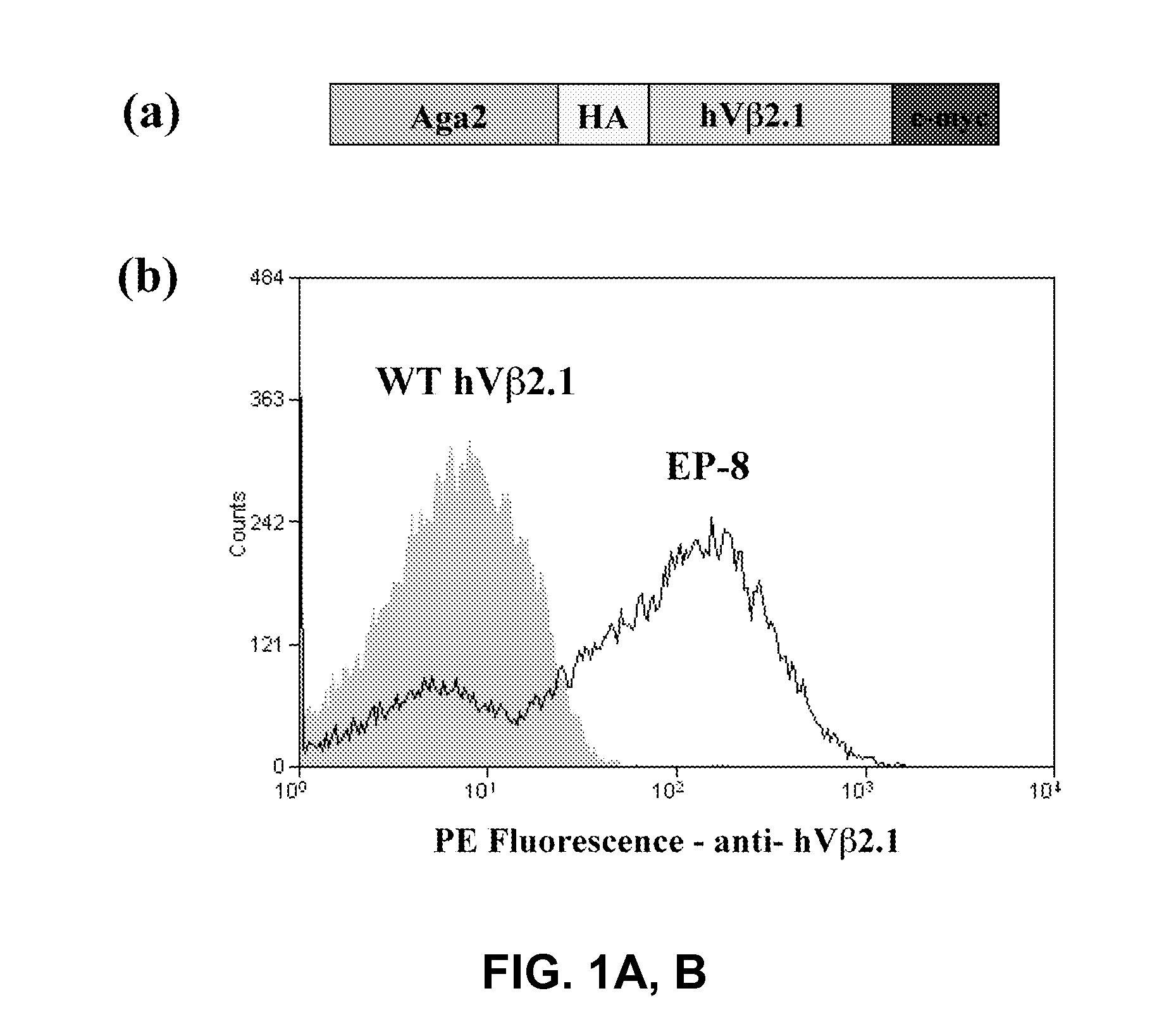Neutralizing Agents for Bacterial Toxins
a technology of bacterial toxins and neutralizing agents, which is applied in the field of neutralizing agents for bacterial toxins, can solve the problems that therapeutics capable of neutralizing their activity are not available for clinical use, and achieve the effects of preventing or reducing the toxic effects and preventing or reducing the binding of a bacterial superantigen
- Summary
- Abstract
- Description
- Claims
- Application Information
AI Technical Summary
Benefits of technology
Problems solved by technology
Method used
Image
Examples
example 1
Engineering T Cell Receptors for High Affinity Binding to TSST-1
[0103]TSST-1 interacts almost exclusively with the human Vβ2.1 (hVβ2.1) region and a significant fraction of patients with TSS exhibit expansions of T cells with hVβ2.1. The structure of hVβ2.1 in complex with SpeC showed that hVβ2.1 uses a greater number of hypervariable regions for contact, compared to the interaction of mouse Vβ8.2 with its three different SAg ligands. Thus, residues from all three complementarity determining regions (CDRs) and hypervariable loop 4 (HV4) contributed contacts with SpeC and the interface exhibited a greater buried surface area than mVβ8.2-SAg interfaces. While the structure of the hVβ2.1-TSST-1 complex has not been solved, a recent alanine mutagenesis study of TSST-1 revealed the key residues of TSST-1 that are involved in the interaction.
[0104]Yeast display techniques were used to engineer the TCR for higher affinity binding to the desired superantigen. These yeast display techniques ...
example 2
Long-Range Cooperative Binding Effects in a T Cell Receptor Variable Domain
[0136]Interactions between proteins are essential for nearly all cellular processes (N. R. Gascoigne et al. (2004) Curr Opin Immunol 16:114-9; T. Pawson et al. (2000) Genes Dev 14:1027-47; A. J. Warren (2002) Curr Opin Struct Biol 12:107-14) and aberrant protein-protein interactions contribute to the pathogenesis of numerous human diseases (J. F. Rual et al. (2005) Nature 437:1173-8). As the genome-wide mapping of protein-protein interactions has identified many of the molecular components of numerous physiological and pathological processes (S. Li et al. (2004) Science 303:540-3; T. Bouwmeester et al. (2004) Nat Cell Biol 6:97-105; L. Giot et al. (2003) Science 302:1727-36; P. Uetz et al. (2000) Nature 403, 623-7; T. Ito et al. (2001) Proc Natl Acad Sci USA 98:4569-74) and structural genomics efforts have determined structures of many of the constituent protein domains involved in these interactions, the abi...
example 3
Soluble Vβ Having High-Affinity for Staphyloccal Enterotoxin B (SEB)
In Vitro Neutralization of SEB-Mediated Activity by Soluble High-Affinity Vβ Regions
[0168]FIG. 21 shows cross-reactivity of mVβ8.2 clones generated for high-affinity to SEB. Yeast clones expressing the indicated Vβ domain on their surface were incubated for one hour on ice with 200 nM biotinylated SEB or SEC3. Binding was measured by flow cytometry. Table 4 shows representative kinetic and affinity parameters.
TABLE 4Binding parameters for affinity matured mVβ8.2 variants interactingwith SEB as measured by surface plasmon resonance analysis1ka (M−1s−1)kd (s−1)KA (M−1)KD (M)G23.81 ± 0.26 × 1062.48 ± 0.23 × 10−31.54 ± 0.04 × 109 6.49 ± 0.16 × 10−10G43.66 ± 0.29 × 1067.13 ± 0.44 × 10−45.13 ± 0.09 × 109 1.95 ± 0.04 × 10−10G5m4-32.99 ± 0.27 × 1062.47 ± 0.40 × 10−41.23 ± 0.18 × 10108.20 ± 1.24 × 10−11G5m4-63.16 ± 0.40 × 1061.91 ± 0.14 × 10−41.65 ± 0.11 × 10106.09 ± 0.42 × 10−11G5m4-83.44 ± 0.20 × 1061.64 ± 0.08 × 10−42.11 ...
PUM
| Property | Measurement | Unit |
|---|---|---|
| Molar density | aaaaa | aaaaa |
| Molar density | aaaaa | aaaaa |
| Molar density | aaaaa | aaaaa |
Abstract
Description
Claims
Application Information
 Login to View More
Login to View More - R&D
- Intellectual Property
- Life Sciences
- Materials
- Tech Scout
- Unparalleled Data Quality
- Higher Quality Content
- 60% Fewer Hallucinations
Browse by: Latest US Patents, China's latest patents, Technical Efficacy Thesaurus, Application Domain, Technology Topic, Popular Technical Reports.
© 2025 PatSnap. All rights reserved.Legal|Privacy policy|Modern Slavery Act Transparency Statement|Sitemap|About US| Contact US: help@patsnap.com



